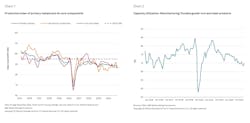S&P Global: Steel and Aluminum Tariffs Would Mean Little Change for GDP, Prices
On Feb. 10, President Trump unveiled plans for 25% tariffs on all US imports of steel and aluminum, which accounted for an estimated $61 billion, or 1.8%, of total goods imported to the US last year. The tariffs are scheduled to go into effect on March 12. They would lead to a substantial increase in the effective tariff rates on these metals (from the current 2.95% on steel imports and 3.91% on aluminum imports).
The President is exercising his authority under Section 232 of the Trade Expansion Act of 1962, claiming the tariffs are in the interest of national security.
S&P Global, a financial intelligence company, has issued its first estimate on how the tariffs could affect consumer prices and GDP. S&P Global Ratings finds that the impact is miniscule, but the indirect effect on downstream sectors that use steel and aluminum—such as automakers and can manufacturers—is potentially large.
The new tariffs would represent a near 0.34 percentage point increase in the effective tariff rate, which would raise the price of imports gross of tariffs by 0.34%. This translates into an approximately 0.04% increase in the personal consumption expenditures price index. US consumers and companies are likely to bear the brunt of the costs, particularly in the first year. But lower foreign producer prices and a stronger dollar exchange rate could help limit the adverse impact on macroeconomic conditions in subsequent years.
The tariffs could reduce goods imports by the same 0.34% assuming unitary demand elasticity, which is likely overstated. All else equal, this would increase GDP by 0.04% in the first year as demand shifts toward domestically produced substitutes—if domestic producers step in to fill the void (again an upper limit).
The announced tariffs come at a time when industrial production and capacity utilization of these metals have declined to unusually low levels (charts 1 and 2).
The overall US steel and aluminum trade deficits stand at $14 billion and $13 billion, respectively, with a notable surplus on both metals with Mexico. Mexico accounts for 36% of US exports of iron and steel (steel accounts for the majority of the iron and steel category), and 29% of US exports of aluminum (see charts 3 and 4). Canada tops the list on US imports of both steel and aluminum (see charts 5 and 6), which totaled $19.5 billion in 2024. The US exported $34 billion of these metals in 2024, or 1.6% of the total goods exported to the rest of the world.
Effective Tariff Rate
Given current US imports of steel and aluminum, the new tariffs represent an estimated $11.2 billion tax increase on American importers of these metals. This leads to a near 0.34 percentage point increase in the effective tariff rate to approximately 2.67%, from 2.33% (calculated as of 2024 data).
In 2024, customs duties from steel and aluminum were $1.8 billion, down from $3.1 billion in 2018. The new tariffs, on a static basis, represent a 15% increase in the 2024 total tariff revenues—or $76 billion, which was just 3.1% of the $2.43 trillion in individual income tax revenue.
Elasticities and Prices
At first pass, we assume the elasticity of demand for imports for these metals is unitary (meaning that a change in price leads to an equal change in the quantity demanded), and the supply of imports for these metals is infinitely elastic in the first year. As a result, the price of imports before tariffs is unchanged and the price of imports after tariffs rises by the full amount of the tariff.
A 0.34 percentage point increase in the tariff rate raises the price of imports gross of tariffs by 0.34%. This translates into a 0.037% increase in the personal consumption expenditures price index using standard import content of consumer spending at 11%. (In other words, about 11% of U.S. consumption can be traced to imports.) It is not surprising that import content of consumer spending is so low given that nearly two-thirds of the consumer price index consists of services, and for most services the largest cost is labor.
History suggests that the costs of tariffs have largely been borne by US consumers and companies. In past instances of new tariffs, almost all of the additional cost was passed through in the first year. A combination of lower foreign producer prices and a stronger dollar exchange rate could mitigate the increase in the cost of steel and aluminum, limiting the adverse impact on macroeconomic conditions in subsequent years.
GDP
Given our unitary demand elasticity, the tariffs reduce goods imports by that same 0.34%. All else equal, this would increase GDP by 0.038% in the first year (goods imports constitute 11.2% of GDP) as demand shifts toward domestically produced substitutes.
Implicit in this calculation is that domestic substitutes can be supplied at the going price and that production of them can be raised instantly. This may be overstating reality. We think there is scope for domestic steel production to pick up without running into capacity constraints (as measured by the average over the long run) in the near term since capacity utilization is running at 10-year lows. This could happen with a tempered impact on prices.
In time, steel tariffs could enable higher pricing and stronger profits for domestic steelmakers. On the other hand, aluminum tariffs wouldn't lead to more output in the US without years of smelting and electricity investments. Dormant cost-efficient domestic primary aluminum capacity does not exist.
Countermeasures from Trading Partners
If history is any guide, the planned tariffs would raise the risk of countermeasures from other countries. These could come in the form of a dispute between members of the Word Trade Organization over trade rules, imposition of tariff/nontariff trade restrictions (including on politically sensitive industries), or some combination of these. These would be negatives for a business environment that just recently received a boost from a friendlier regulatory environment and a perception of forthcoming tax cuts.
The 2018 steel and aluminum tariffs led to countermeasures from Canada, China, the EU, and Mexico. According to S&P Global Market Intelligence, many duties were targeted at US agrifood exports, including EU tariffs on distilled spirits, juices, butter, cheese, and pork. Big manufacturers like Boeing also lost access to international markets.
President Trump hinted that farmers, if targeted in retaliation to any new tariffs, would be helped (presumably from the tariff revenues collected). Indeed, during the first Trump term, the administration authorized $61 billion in emergency relief payments to cushion farmers and ranchers from any retaliation, an amount roughly equivalent to all of the tariff revenue collected from US businesses.
Downstream Impact
The $11 billion (additional) hit on import costs is negligible in a $29 trillion economy, but the effect of tariffs would not be limited to the prices of imported steel and aluminum. The downstream users of steel and aluminum, such as the construction and auto industries, will be affected disproportionately.
Higher prices for imported products could ease competitive pressure that the US producers are under. It could also lead US producers to raise their prices—citing the new tariffs as the reason. That means US producers that rely heavily on imports of steel and aluminum would likely see their cost of doing business rise.
All else equal, the tariffs would increase costs to automakers, food processing and packaging including can manufacturers, construction projects including homebuilding and infrastructure, and possibly defense contractors. Tariffs and nontariff barriers tend to disproportionately burden the small and midsize businesses. Profits are likely to be squeezed at the margin.
To the extent businesses can pass on the rising cost, consumers would also eventually see their prices increase. Overall, pressure on inflation would rise just as markets and consumers are appearing to be sensitive to inflationary expectations.
For further insights, visit S&P Global Insights at www.spglobal.com/en.

